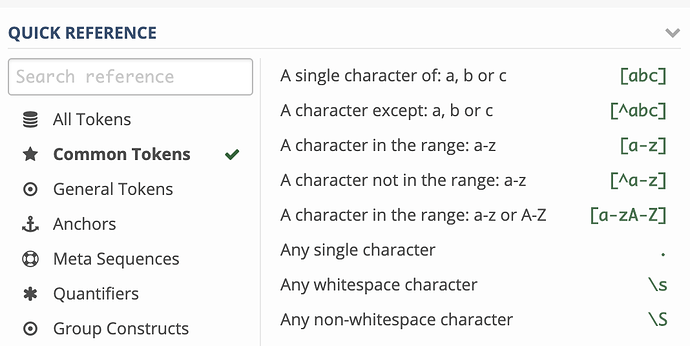最近经常经常进行文本内容以及文件的搜索还有文件的批量修改等,日常简单的搜索已经满足不了自己的需求,于是花了一点时间了解了并操作了一些知识。大家对于学习正则表达式有什么吗?各种类型的正则表达式emacs风格的,perl, python, java,.net等都有自己的正则表达式,有时候感觉容易搞乱掉。
有本叫什么精通正则表达式的书看着不错,虽然名字听起来很水。
一本书《精通正则表达式》Yahoo工程师写的,非常不错。
学完以后,配合 re-builder 这个插件多练习,实践出真知。
自己写一个正则engine就会了
正则表达式一般有两种: POSIX和PCRE( Perl Compatible Regular Expressions),后者被广泛使用。虽然每个语言的正则写法有一点不一样,但是大致原理都差不多。我平时使用用 visual-regexp.el 来测试正则表达式,这个lib使用的是PCRE标准的,写完以后大多数都直接用于生产项目中。
而 rebuilder 一般用来写elisp的正则。
学会基本原理才是王道。 regex101.com 里面有一个表,学会这些基本就够用了,再复杂的可以上网查找,或者使用Emacs插件去辅助写正则(复杂的正则如果没有可视化方法编写会非常痛苦)。
只是用的话完全没必要。
使用手册: https://www.regular-expressions.info
可视化正则表达式: https://regexper.com
source code: Jeff Avallone / regexper-static · GitLab
你猜他在干嘛?
— My reply:
I am guessing you are try to find this string
lkjciidsofwopvqi-something
in this string long string
flkjciidsofwopvqi-something
But I got:
Debugger entered--Lisp error: (invalid-read-syntax ") or . in a vector")
read(#<buffer *scratch*>)
elisp--preceding-sexp()
elisp--eval-last-sexp(nil)
eval-last-sexp(nil)
funcall-interactively(eval-last-sexp nil)
call-interactively(eval-last-sexp nil nil)
command-execute(eval-last-sexp)
Looks like I am missing some context here.
This is my learning:
- matches two or more blank lines in sequence.
(re-search-forward "^\n\\{2,\\}")
- match TODO
(re-search-forward "\\[TODO\\](\\([^\\)]+\\))" nil t)
- match UUID
(re-search-forward "PDFNAME::\\([a-zA-Z0-9 \.\_\,\-]+\\)\.pdf - " nil t)
- match page number
(re-search-forward "PAGENUM::\\([0-9]+\\)::END" nil t)
- match secrete
(re-search-forward (concat arg "::\\(.*\\)"))
- match @dfn{xxx}
(re-search-forward "@dfn{\\([^}]+\\)}" nil t)
- match end sentence
(re-search-forward "[\.,;:!\?]" end t)
If you know python: and interested in nCoV:
overall_information = re.search(r'\{("id".*?)\]\}', str(soup.find('script', attrs={'id': 'getStatisticsService'})))
province_information = re.search(r'\[(.*?)\]', str(soup.find('script', attrs={'id': 'getListByCountryTypeService1'})))
area_information = re.search(r'\[(.*)\]', str(soup.find('script', attrs={'id': 'getAreaStat'})))
abroad_information = re.search(r'\[(.*)\]', str(soup.find('script', attrs={'id': 'getListByCountryTypeService2'})))
news = re.search(r'\[(.*?)\]', str(soup.find('script', attrs={'id': 'getTimelineService'})))
if you intersted in bash
find xxx from grep_xxx
$(grep -oP '(?<=aoa_)[0-9]+' tmp)
inspired by @manateelazycat
why github is unhappy with rep name regexp? Possible related to their reg engine?
-
oh my god, why regexp is everywhere…
-
proudly power by org-mode
根据我自己的理解:
一般日常使用的 “正则表达式” 实际上就是一种描述 “正则语言” 的表达式(或程序语言).
什么是正则语言呢:
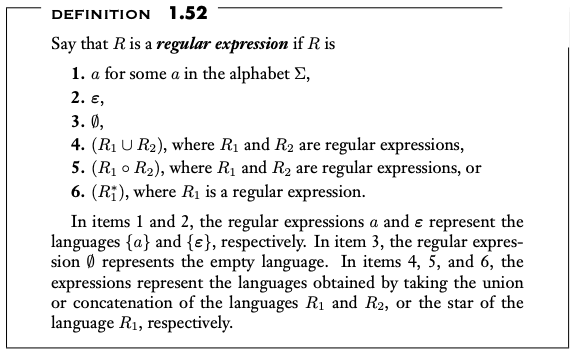
(这幅图里面的 regular expression 实际上指的是 “正则语言”, 是满足一定要求的句子的集合)
上面这幅图中用到的三个运算的定义如下:
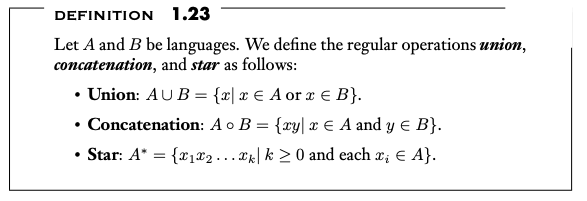
(上图中的x, y都表示句子. xy不是乘法, 而是连接: 如果 x = “abcde”, y = “fgh”, 则xy = “abcdefgh”)
你看到的各种版本的正则表达式虽然各不相同, 但是他们实际上都在描述上面提到的正则语言. 由于正则语言的定义是十分简单的, 所以实际上, 只需要实现Union, Concatenation, Star三种基本的运算, 就相当于实现了正则表达式. 除了这三种运算之外的部分, 都相当于是语法糖(即使你不学也可以通过这三种运算构造出来等价的表达式).
我也比较赞同实现一个正则engine的说法, 知道原理之后, 大概花1-2天就能写出来. 正则engine一般通过模拟 非确定有限自动机 进而正确识别正则语言中的句子.
上面提到的三种运算都可以对应到对于有限自动机的操作:
Union N1 and N2
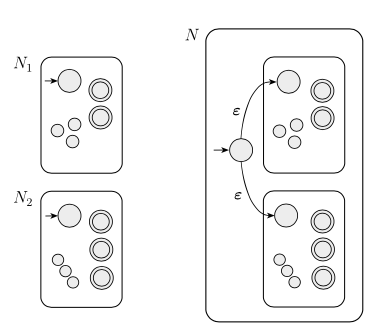
Cancatenation N1 and N2
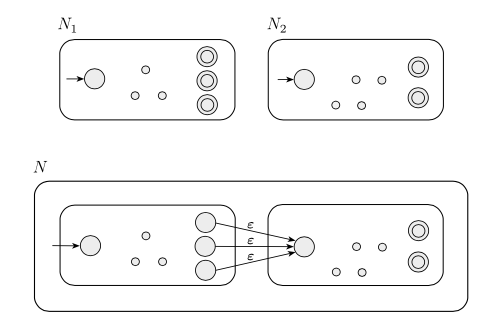
Star of N1
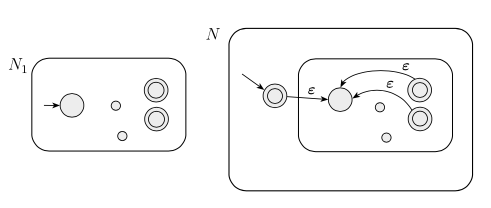
如果你希望深入学习, 可以阅读Michael Sipser写的《Introduction to the Theory of Computation》这本书
上面这些概念可以帮你分清主次, 应该可以解决你的问题. 甚至进一步的, 可以让你认识到正则表达式的局限性, 帮你判断自己的需求是否能够使用正则表达式完成.
我找了个中文的
要注意看的是 实际世界当中的正则表达式
我靠,我只能说牛逼。。。。直接看不懂了
 我说怎么这么眼熟,上学期刚学完这节课。)像我前面说的,如果只是想用的话,简单易懂的新手教程更有用
我说怎么这么眼熟,上学期刚学完这节课。)像我前面说的,如果只是想用的话,简单易懂的新手教程更有用
楼主只是学正则去处理数据,没必要花时间看理论或者写一个什么engine
这是高手。。。
我记得我学这个的时候。。。
概要
I like.
thanks for this useful information
I will try my best
Thompson NFA is so fast!
we don’t know what he wants.
Would like to share what you learn? I want ask questions.
In case someone wnats to learn:
Do you know what this reg is searching for?
一个实时的调试环境对于书写正确的正则表达式会有帮助,这里有个 Python 的: https://pythex.org/ 。
当然, Emacs 中已经内置了这样的功能: M-x regex-builder ![]()
UPDATE: regex-builder 是 re-builder 的别名,如果没有试试 M-x re-builder 。
找不到这个哎
那试试 M-x re-builder ,刚注意到 regex-builder 是一个 alias ,旧版本中可能没定义。
